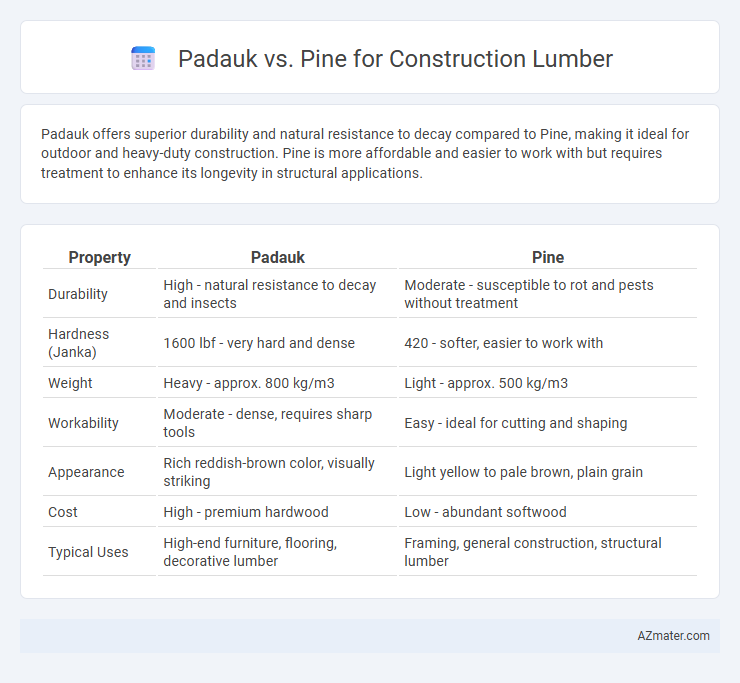Padauk offers superior durability and natural resistance to decay compared to Pine, making it ideal for outdoor and heavy-duty construction. Pine is more affordable and easier to work with but requires treatment to enhance its longevity in structural applications.
Table of Comparison
| Property | Padauk | Pine |
|---|---|---|
| Durability | High - natural resistance to decay and insects | Moderate - susceptible to rot and pests without treatment |
| Hardness (Janka) | 1600 lbf - very hard and dense | 420 - softer, easier to work with |
| Weight | Heavy - approx. 800 kg/m3 | Light - approx. 500 kg/m3 |
| Workability | Moderate - dense, requires sharp tools | Easy - ideal for cutting and shaping |
| Appearance | Rich reddish-brown color, visually striking | Light yellow to pale brown, plain grain |
| Cost | High - premium hardwood | Low - abundant softwood |
| Typical Uses | High-end furniture, flooring, decorative lumber | Framing, general construction, structural lumber |
Introduction to Padauk and Pine as Construction Lumber
Padauk is a dense hardwood known for its vibrant reddish-orange hue, durability, and resistance to decay, making it ideal for high-quality construction lumber in outdoor and decorative applications. Pine, a softwood, offers a lightweight and cost-effective option favored in structural framing and general construction due to its ease of handling and availability. Both species provide distinct advantages, with Padauk excelling in longevity and aesthetics, while Pine delivers versatility and affordability in building projects.
Botanical Origins and Distribution
Padauk, derived from several Pterocarpus species native to tropical Africa and Southeast Asia, exhibits a dense, durable hardwood ideal for high-end construction and furniture. Pine, sourced mainly from Pinus species widespread across the Northern Hemisphere in temperate regions, offers a versatile softwood commonly used in framing, paneling, and general construction due to its fast growth and availability. The contrasting botanical origins--tropical hardwood versus temperate softwood--directly influence their distribution, physical properties, and suitability in varying construction applications.
Physical Properties Comparison
Padauk wood exhibits significantly higher density, ranging from 600 to 850 kg/m3, compared to Pine's lighter density of 350 to 550 kg/m3, offering greater strength and durability for construction purposes. The Janka hardness of Padauk averages around 1,700 lbf, substantially harder than Pine's 380 to 870 lbf, making it more resistant to dents and wear. Dimensional stability in Padauk is superior due to its lower shrinkage rates, ensuring better structural integrity and reduced warping in varied environmental conditions.
Strength and Durability
Padauk offers superior strength and exceptional durability compared to pine, making it ideal for heavy construction projects requiring long-lasting materials. While pine is lightweight and easier to work with, it is more prone to dents, scratches, and decay under harsh environmental conditions. Padauk's dense grain structure and natural resistance to rot and insects provide enhanced structural integrity and longevity in demanding applications.
Workability and Machining
Padauk offers superior workability compared to pine, featuring a dense grain that machines smoothly without excessive tear-out or splintering. Pine, being softer and less dense, is easier to cut and shape manually but may dent or chip more easily during machining processes. Tools last longer and finishes adhere better on padauk, making it ideal for projects requiring fine detailing and durability in construction lumber.
Resistance to Decay and Insects
Padauk offers superior resistance to decay and insects compared to pine, making it a preferred choice for outdoor and high-moisture construction applications. Its natural oils and dense grain structure enhance durability and reduce susceptibility to fungal attacks and termite infestations. Pine, being a softer wood with lower natural oil content, requires chemical treatments to improve its resistance for similar uses.
Aesthetic Qualities: Color and Grain
Padauk lumber stands out with its vibrant reddish-orange color that deepens to a rich mahogany over time, offering a bold, warm aesthetic ideal for high-end furniture and decorative accents. Pine lumber features a pale yellow to light brown hue with distinct, knotty grain patterns, creating a rustic, casual look suitable for structural framing and casual furnishings. The smooth texture and striking color stability of Padauk contrast with the softer, more uniform grain and natural imperfections found in Pine, influencing design choices based on visual impact and style preferences.
Environmental Impact and Sustainability
Padauk lumber, derived from the Pterocarpus species, is valued for its durability and rich color but faces sustainability concerns due to overharvesting and slow growth rates in tropical forests. Pine, particularly fast-growing species like Radiata and Southern Yellow Pine, offers a more sustainable option with faster renewal cycles and widespread forestry management practices promoting carbon sequestration and reduced environmental impact. Sustainable pine harvesting paired with certified forestry programs, such as FSC and PEFC, supports responsible lumber production compared to the often unregulated sourcing of Padauk, making pine a preferable choice for eco-conscious construction projects.
Cost and Availability
Padauk lumber typically commands a higher price than pine due to its dense hardwood properties and limited regional availability, often sourced from Central and West Africa or Southeast Asia. Pine, as a softwood, is widely available globally with large-scale plantations, leading to significantly lower costs and easier procurement for construction purposes. The choice between Padauk and Pine hinges on budget constraints and the need for durability, where Pine offers cost-effectiveness and accessibility while Padauk provides superior strength at a premium price.
Best Applications in Construction
Padauk offers exceptional durability and natural resistance to decay and insects, making it ideal for outdoor construction projects like decking, flooring, and heavy-duty structural elements. Pine, known for its affordability and ease of workability, is best suited for interior framing, lightweight structures, and temporary scaffolding where cost-efficiency and quick installation are priorities. Choosing Padauk or Pine depends on project requirements such as load-bearing capacity, weather exposure, and budget constraints in construction applications.

Infographic: Padauk vs Pine for Construction Lumber
 azmater.com
azmater.com